Wednesday, November 30, 2022
Barthes: Narrative Enigma
Todorov: Narrative Structure
Tzvetan Todorov
What is Narrative Structure?
Example:
Tuesday, November 29, 2022
Male Gaze and Voyeurism
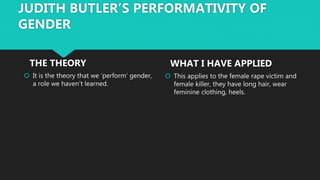
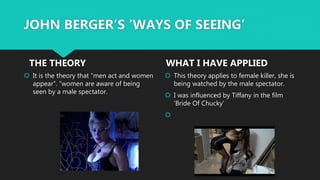

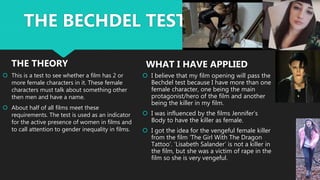

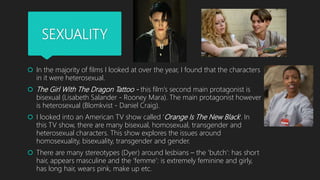
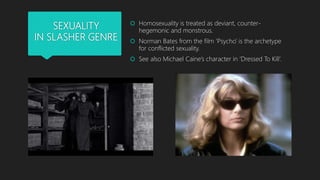
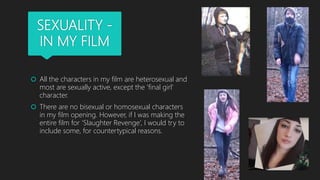


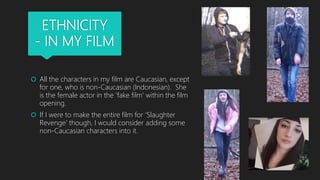
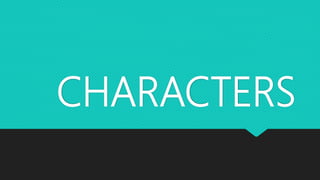

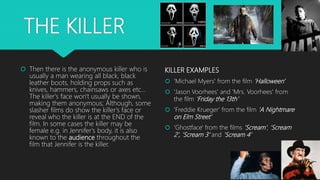
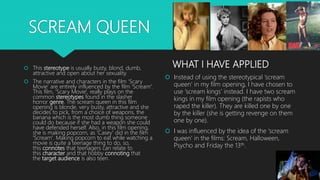

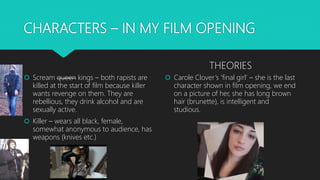
 The Male Gaze:
The Male Gaze:
"the perspective of a notionally typical heterosexual man considered as embodied in the audience or intended audience for films and other visual media, characterised by a tendency to objectify or sexualise women."
- the man behind the camera- the male character- the male spectator
Background:
The first documentation of "the gaze" or "le regard" was introduced by the French philosopher Jean-Paul Sartre in 1943. He described it as "the act of gazing at another human creates a power difference, felt by the gazer viewing the gazed as an object rather than a human being."
The first use in cinema was by John Berger in 1972's "Ways of Seeing", where his theory stated that "men act and women appear", with women being aware of their obligation of performance towards the male viewer.
It most notably appears in Laura Mulvey's 1975 essay "Visual Pleasure and Narrative Cinema". In this essay, she states, "In a world ordered by sexual imbalance, pleasure in looking has been split between active male and passive female." (808), relating the representations of women and men in cinema to the patriarchal structure of society. These representations deny the post-feminist theory of agency, or a woman's control over her actions and body, dehumanising her and being viewed as a body rather than a person.
Psychology of the theory:
Mulvey based her essay on several Freudian psychoanalytical concepts:
Male Castration Anxiety: Upon viewing the woman, her lack of phallus poses the threat of castration to the male, and therefore displeasure. This unconscious anxiety of the male in turn leads to the over sexualisation and passive role of women onscreen, through voyeurism and fetishisation.
Voyeurism: The behaviour of looking as a sexual pleasure . Mulvey states it is about "asserting control and subjecting the guilty person through punishment or forgiveness." By viewing and fragmenting the female body, the anxiety of castration is reduced.
Scopophilia: The receiving of pleasure from looking, relating to the effects of the male gaze on both men and women. When the pleasure is derived from sexual attraction, it falls under the voyeuristic pleasure. However, when women view film from the male perspective, their pleasure is derived from self-identification and narcissism.
Narcissism: Receiving pleasure from the contemplation of one's self, in this case women identifying with their onscreen objectification.
Spectatorship:
When viewing a film, the viewer assumes the role of the active male or the passive female. Mulvey states that the male gaze consists of "three different looks"; the camera, the audience, and the characters. They all share the perspective of the active male viewer, relating to the concept of scopophilia or pleasure from viewing. This is in turn separated into two categories; voyeurism, where the subject is viewed from a distance and the viewer projects onto them, or narcissism, where the subject is recognised within it's viewer.
Due to this system of viewing, Mulvey believed women must identify with male characters and their perspective in order to enjoy films.
Onscreen, the male perspective is physically distinguishable in the camera's sight line and women are objectified to appeal to the male character, or male viewer. This is reinforced by the patriarchal hegemony (Gramsci), as well as other forms of media.
Rejection of the gaze:
Camille Paglia, a feminist academic writer, rejected the theory of the male gaze, by prioritising the post-feminist theory of agency. She says "I've been very vocal about my opposition to the simplistic theory of the male gaze... (it is) the victim model of feminism applied to the works of culture."
The female gaze was idealised later, with the idea consisting of a female assuming the position of the dominant male, and viewing through this perspective, removing the objectification of women.
Queering the gaze, consists of a same sex viewer and object, therefore queering the passive and active or male and female roles. However, this is also criticised by many feminist theorists, specifically regarding the lesbian gaze, referring to the fetishisation occurring from the heterosexual male.
Wednesday, November 23, 2022
Production Budget
Accessories: £20 (Matching items)
Locker decorations: Free (Own)
Books: Free (Actors')
Butler: Gender Performativity
What is Gender Performativity?
Possible influences for my film:
Sample Scene 2
After our initial sample scene, we wanted to create another using as many possible elements to include in our final scene.
We created the mise-en-scene of the locker and the missing posters. The inside of the locker is decorated with some pictures of our cast as well as various lipglosses for Mandy to use. The poster on the locker was placed so it could be visible for the majority of our takes. We also added a mirror inside the locker to create a close up using it, and potentially for our jump scare.For the costumes, we wanted to use as many pieces we thought we wold include in our final cut, such as the fake glasses, heart earrings and heart jumper. Through our composition of the mise-en-scene and costumes, we were able to have a more accurate representation of our intended scene, and see the possible difficulties we could face while filming.
 After creating a call sheet for the scene, we had a basic idea of shots to film and elements of continuity to be aware of. This was very helpful to us as we only had 45 minutes to film, and we made sure to include the necessary shots before experimenting further.
After creating a call sheet for the scene, we had a basic idea of shots to film and elements of continuity to be aware of. This was very helpful to us as we only had 45 minutes to film, and we made sure to include the necessary shots before experimenting further. Abel Ferrara Masterclass
Although I hadn't previously seen any of Ferrara's films I was aware of his longtime work with Willem Dafoe and Asia Argento, who are two actors I admire. I took notes throughout the Masterclass, and asked a question myself.
Here are some of the notes I wrote down:
A: I don't deal with constraints, once I receive the money I have no constraints. I've been working since I was 16, but I don't work for anyone, I am free. Stanley Kubrick's movie's are an inverted pyramid of one idea, which inspires my work strategy.
Tuesday, November 22, 2022
Production Schedule
Intertextuality and References
For our film opening, we want to include various intertextual references to previous slasher/horror films we were inspired by. This is also to attract a secondary target audience of 25-44+, who would understand these references.
To present the intertextuality of the film opening, I created a YouTube video with a voice-over explaining the I Saw/I Did approach I took.
Friday, November 18, 2022
Agency
What is Agency?:
Camille Paglia, a feminist academic writer, rejected the theory of the male gaze, by prioritising the post-feminist theory of agency. She says "I've been very vocal about my opposition to the simplistic theory of the male gaze... (it is) the victim model of feminism applied to the works of culture."
Wednesday, November 16, 2022
Levi-Strauss: Binary Opposition
What is Binary Opposition?
Possible influences for my film:
Campbell: Hero's Journey/Monomyth
(b. 1904 - d. 1987)
Joseph Campbell was an American writer, professor, and folklorist.
What is the Hero's Journey/Monomyth?:
The term Monomyth was first seen in his 1949 book "The Hero with a Thousand Faces", where Campbell stated that the journey of the archetypal (Propp) hero spanned across mythology, hence why it is called the Monomyth. He stated that this is the ultimate archetype in the narrative, but the phrase "hero's journey" is more commonly used to describe the protagonists change within a narrative.
Campbell states there are 17 stages of the Monomyth, but certain narratives chose to focus on fewer stages, or in different orders. However, they are separated into three stages: departure, initiation, and return.
Possible influence for my film:
The hero's journey of the final girl or the teenagers in discovering and killing the killer.
Tuesday, November 15, 2022
Sample Scene 1
When shooting our real scene, we will need extras as well as the main actors to create verisimilitude. We have also decided to shoot using iPhone instead of a DSLR camera as it's more versatile and we can get more of the shots we want.
To attempt a sense of binary opposition (Levi-Strauss), I dressed in darker colours, while Sasha mostly wore white.
Here is our sample script:
While shooting, we tried different angles and ideas so that we could create a storyboard through our practice shots. Below, we have our sample video for stepping on a missing poster, something we want to add in our first few shots.
Target Audience
The genre of the film is a teen slasher, the post analysing the genre conventions is linked here.
Age:
Gender:
Class:
Nationality:
Sexuality:
Welcome To My Blog!
Hello! My name is Laura and this is my blog tracking my AS Media Coursework from 2022-2023. I specifically researched film openings and the...

-
Background and development: It develops from passive media theories such as the hypodermic needle model from the 1940s, which places the ...
-
EVALUATION Q1a: How Does Your Product Use Or Challenge Conventions? To summarise this question in a creative way, I decided to replicate Vog...
-
Hello! My name is Laura and this is my blog tracking my AS Media Coursework from 2022-2023. I specifically researched film openings and the...








-1.png)




